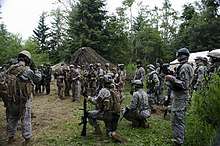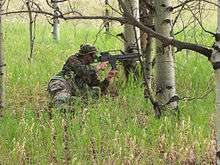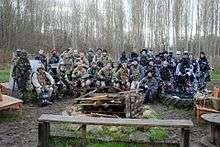MilSim
MilSim, an abbreviation of military simulation, refers to armed confrontation scenarios conducted by civilians for entertainment and mental health purposes.[1][2]

MilSim, in general, is an activity that strives to realistically simulate the experience of armed conflict. There are several forms of MilSim: airsoft, paintball, and video games, simulating military scenarios and tactics. Weapons used in real-life MilSim are commonly replica toy guns. Airsoft guns are used more often in MilSim than paintball guns, due to their realism and inexpensive ammunition.
MilSim events can span between historic military battles, law enforcement-style engagements, or small skirmishes.[3] Large events usually have rigid requirements for entry, and can span between hours and several days without leaving the battlefield. The experience often includes camping, food preparation, and transportation logistics. MilSim differs from the sports of airsoft or paintball - though both rely on tactics and marksmanship, MilSim has a focus on real-world accuracy.[3] There are often fireteams with designated roles, such as simulated combat medics and support gunners.
Loosely originating in Japan in the 1980s, MilSim events are now worldwide, bolstered by an active and expanding Internet scene. American presenter MSATO claims that MilSim is "fastest-growing extreme sport worldwide."[4] The largest events can attract hundreds or thousands of attendees, though players must source their own equipment, such as specific uniforms, radios, and weapons. The attendees are diverse, consisting of hobbyists, military veterans, or those as young as 13. Events range in intensity & requirements. In the United Kingdom, airsoft event organizers run in conjunction with Live Action Role-Players (see LARP) at British Army training facilities, such as Copehill Down and Catterick Garrison. Other combat stages are salvaged from abandoned buildings and private woodland. Many of the larger playfields are leased to ROTC groups or civilian first-responders for simulation training.[1]
Reenactments

Similar to historical reenactments, MilSim reenactments have a focus on historical accuracy to a specific event. All weaponry, uniforms, and equipment are required or suggested to be period-accurate. Food, terminology, and living arrangements can be inspired by the period. Events can be generally 'themed', such as World War II, Desert Storm, or the Yugoslav Wars. Sides are usually not glorified, and attendees are encouraged to see battles through the eyes of a soldier.
Unlike historical reenactments, which use choreographed actors, the general public is participating under a set of rules. The outcome of battles can change, as players act with autonomy. When attendees must source their own equipment, costs can sometimes be thousands of dollars.[4] Occasionally, loaner equipment is provided to beginners.
The world's largest D-Day reenactment, Oklahoma D-Day, features parades, flag raisings, salutes, and reunions, culminating in a "5,000-player rally for the climactic surge at Colleville".[1]
War historians are occasionally consulted to help stage the field.[1] Regularly, military veterans from several nations will attend or organize events, giving further accuracy to first-aid training, current terminology, clothing, and tactics.[3]
Some event organizers, especially those located in the former Soviet Bloc, have access to genuine military tanks, APCs, trucks, and rarely helicopters, which are employed on the field.
Simulations
MilSim simulations are fictionalized scenarios with a realistic objective. Simulations can include hostage rescue, bomb defusal, or fictionalized skirmishes, and include law enforcement or militia-themed scenarios. These promote a "tactical playstyle" above casual airsoft.[3] Players are often given an extensive briefing, containing storylines, mission tactics, and rules of engagement. Most simulations strive for immersion and tension in players.[4] MilSim simulations are usually smaller and more frequent than reenactments.
Uses

Robert Silverman of Vocativ, embedded in a two-day MilSim (inspired by 2003's Tears of the Sun), writes that "the appeal is in ... the realism of an unreal world, plus a deep desire for the camaraderie and teamwork you'd find in a real military unit." He speculates that the "pure adrenaline free from inflicting actual harm ... strikes at something embedded deeply within the core of sports."[4]
Places Journal, referring to the presence of veteran and civilian players, describes MilSim as a "ladder leading up to war and a ladder for coming back down". Notably, veterans (rather than, or in addition to, mental health care) "use war games as self-administered PTSD treatment".[1][2]
The movement of troops among the cacophony of heavy machines provides an immersive sensory environment for exposure therapy. With social support, it may be possible for vets to defeat their darkest fears (although Veterans Affairs advises against high-adrenaline treatments that might trigger flashbacks).
Recently, advances in airsoft replica authenticity have led numerous law enforcement and military units to train with airsoft guns in CQB/CQC environments. MilSim events have encouraged the US Army to promote enlistment.[1]
Video games
Mil-sim is also a genre of video games, sometimes overlapping with the tactical shooter genre, wherein there are more "realistic" mechanics and consequences compared to other first-person shooters or action games. Games such as ArmA are a realistic simulation of equipment and tactics, rather than pure entertainment, and are sometimes used to train soldiers. Other games, such as the Red Orchestra series or the Battlefield series, feature some realistic aspects in their gameplay. Mil-sims can be differentiated from other shooter games in that, usually:
- Firearms are modeled after real life. Bullets are grouped by magazines (rather than an invisible ammo pool), gunshot wounds are mostly fatal, and bullets are physically simulated, requiring the player to account for wind and gravity.
- The games' systems account for various needs. Vehicles may have limited cargo space, and characters can become severely fatigued. Hunger and thirst may also deplete.
- Community-run MilSim events, within these video games, often have players undergo "training". A player might be trained in military tactics that will give them an advantage in the game.
References
- Dusseault, Ruth; Shanks, Michael (2014-11-03). "Play War: Homemade Recreational Battlefields". Places Journal (2014). doi:10.22269/141103.
- LeDoux, Joseph E. (1949- ...)., Auteur. (2009). Post-Traumatic Stress Disorder : Basic Science and Clinical Practice. Humana Press. ISBN 9781603273299. OCLC 690366027.CS1 maint: multiple names: authors list (link)
- "What is MilSim?". Abbey Supply. Archived from the original on 31 October 2018.
- "War Games: Inside The Hardcore World Of Military Simulations". Vocativ. 2016-09-07. Retrieved 2019-10-13.